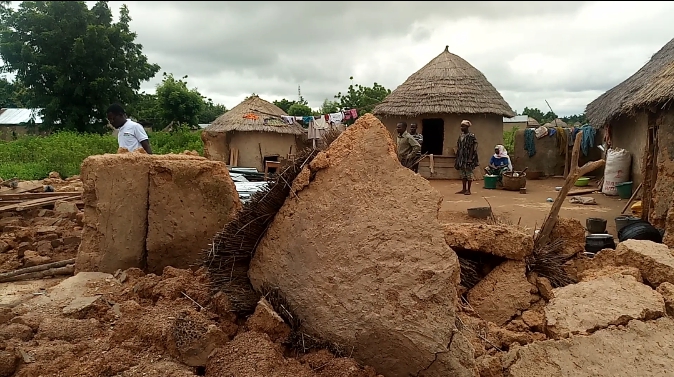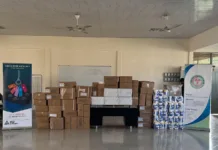
A devastating twin occurrence of a dam spillage at Bagre in neighbouring Burkina Faso and weeks of heavy downpour in the Northern Region have left at least six people dead and over half a million without their homes and properties.
Torrential rainfalls have been pounding the region with an unprecedented intensity that swelled rivers, ripped apart hundreds of major and rural roads, ruined utility connections and crumpled dozens of thatched buildings across the region.
The combined impact of the dam spillage and the massive downpours have also left two hundred thousand residents in the region cut off from accessing district capitals and basic amenities and several dozen farmers scrambling to salvage their drowning produces.
The spillage is an annual occurrence where billions of gallons of water are released from the Bagre dam. The waters are barreled dangerously into tributaries of the White Volta River in the Northern and Upper East regions starting from Gbeongo at Zebilla, uprooting trees, turning farmlands into rivers, forcing families to abandon homes.
About 185 communities within the SADA Zone with an estimated population of more than 200, 000 are always at risk when volumes of flood waters are pumped out by authorities at the Bagre Hydro Plant in Burkina Faso.
The dam is mostly spilt around August and September each year when the dam could no longer contain above its 235m depth.

The unpredictability of rain pattern last year couldn’t cause the dam to swell to warrant a spillage, however, as the rains return this year, a humanitarian catastrophe looms large as thousands of people have already lost their homes and farms.
More than 50hectares of farmland have been destroyed and many forced to evacuate from homes to high grounds in the West Mamprusi District.
Nearly half of communities in the North Gonja district are cut off as waters from the Bagre dam continue to inundate farmlands and destroy crops.
Residents of Mamprugu Moiduru (Oversea district) who use to access parts of the region through Walewale now travel through Upper East region due to massive destruction caused by the spillage and lashing rains.
“I’m currently in Tamale, when I was coming I had to pass through Bolga and it even affected my car engine. The whole place is flooded. Most of the communities around the rivers and are farming at the banks are already in great loss,” the District Chief Executive, Abu Adams told Starr News by telephone.
In the Savelugu Municipality, torrential downpour and the dam spillage flooded many homes, farms and killed at least three people.
The District Chief Executive of the Central Gonja district, Dr Mustapha Mahama confirmed that thousands of people have been cut off from the district capital and unable to access healthcare.

“The spillage of the dam and increasing rainfall are swelling the black and white Volta Rivers. Some of the bridges have been washed away in the Tuluwe area. Though we have some health centres, definitely it’s going to affect the people,” Dr Mustapha said.
The damaging impacts of the dam spillage and heavy rains continue to damage the already bad roads, cutting off several districts including Saboba, Nanumba North and South, Kpandai, Salaga, leaving residents in desperate situations.
Thomas Mbomba, DCE of Tatale, said more roads leading to over 30 communities in the district are currently inaccessible and many residents have been trapped.
Saboba DCE, John Bingirni told Starr News the major road from Yendi to the district had been submerged by floodwaters and many farmers have lost farmlands.
In the Tolon district, rainfalls have destroyed over 120 houses, displacing nearly a thousand residents.
Residents of Pishegu and surrounding communities in the Karaga district currently engaged in communal labour service almost a week now, carrying trunks of trees and heavy rocks to patch their roads which bridges have been washed away.
According to Alhassan Yabdoo, the DCE, some communities have been affected by the phenomena and that the assembly is putting measures to mitigate the impacts of the situations on the people in the area.
The Northern Regional Minister Salifu Saeed embarked on a tour of the affected areas by helicopter with other members of the regional Security Council Thursday.
Salifu Saeed said he was “devastated and touched” by the state of damage caused by the floods.
The Minister said government would begin emergency works on the damaged roads in earnest to ensure accessibility for farmers to be able to transport their produce to market centres and warehouses.
He urged affected residents to remain calm as government puts “pragmatic measures to turn this perennial flooding problem into an opportunity, giving the fact that, technology is now leading development; so we now need to look beyond Ghana to get experts, engineering intervention so that there can be multiple dams that be put within the belt that the water flows through, so that these dams can serve as reservoirs to store the water.”
“Because people have used their limited resources to invest in their farmlands and the way the floods have come is really a challenge that has been possed to us in our respective regions and as a government,” said Mr Saeed.
“I’m aware that a number of feeder roads have been damaged and destroyed, so these are the issues that of serious concern because when the water recedes, definitely after harvesting they need the roads to cart their produce to market centres and the way the water has washed away some of the roads, it means that we really need to do some emergency works to fix the roads,” he added.
Source: Ghana/Starrfmonline.com/103.5FM/Eliasu Tanko




